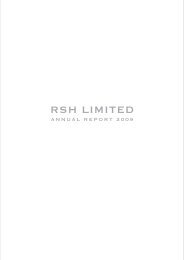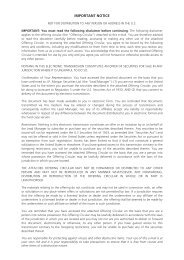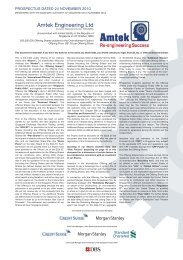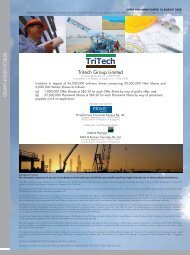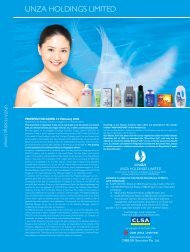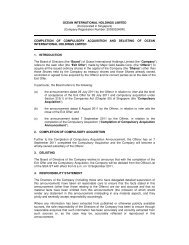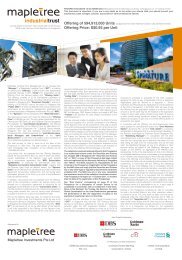- Page 1 and 2:
OTTO MARINE LIMITED PROSPECTUS DATE
- Page 3 and 4:
Our Financial Highlights Over the l
- Page 5 and 6:
Our Strategies We intend to consoli
- Page 7 and 8:
NOTICE TO INVESTORS. ..............
- Page 9 and 10:
All references to the “Latest Pra
- Page 11 and 12:
CORPORATE INFORMATION Board of Dire
- Page 13 and 14:
United Overseas Bank Limited 80 Raf
- Page 15 and 16:
SUMMARY The following summary is qu
- Page 17 and 18:
Strategies We intend to consolidate
- Page 19 and 20:
The Offering The Issuer ...........
- Page 21 and 22:
on the SGX-ST will be in Singapore
- Page 23 and 24:
Consolidated Balance Sheets As at A
- Page 25 and 26:
INDICATIVE TIMETABLE The indicative
- Page 27 and 28:
Risks Relating to Our Business and
- Page 29 and 30:
companies and their affiliates acco
- Page 31 and 32:
more of the administrative tasks an
- Page 33 and 34:
Labour problems may disrupt our ope
- Page 35 and 36:
Our operations may be adversely aff
- Page 37 and 38:
The exchange price for the first tr
- Page 39 and 40:
American-led military campaigns in
- Page 41 and 42:
liquidity, the price of such shares
- Page 43 and 44:
Over Code. A take-over offer is als
- Page 45 and 46:
able to use the net proceeds to mak
- Page 47 and 48:
EXCHANGE RATES AND EXCHANGE CONTROL
- Page 49 and 50: CAPITALISATION AND INDEBTEDNESS The
- Page 51 and 52: (2) As at 1 January 2005, Yaw Chee
- Page 53 and 54: Consolidated Balance Sheets As at A
- Page 55 and 56: MANAGEMENT’S DISCUSSION AND ANALY
- Page 57 and 58: uilding such vessels. Higher demand
- Page 59 and 60: Demand for and Supply of Skilled La
- Page 61 and 62: Deferred Gain Deferred gain arises
- Page 63 and 64: Cost of Sales Our cost of sales con
- Page 65 and 66: Recognition — Deferred Gain”. O
- Page 67 and 68: evenue from the Middle East region
- Page 69 and 70: In FY2007, our revenue from the Mid
- Page 71 and 72: Cost of Sales Our cost of sales inc
- Page 73 and 74: In FY2007, our net cash from operat
- Page 75 and 76: Facility Lender Amount of Facility
- Page 77 and 78: Hong Leong Finance We have obtained
- Page 79 and 80: staff members who were hired from 2
- Page 81 and 82: amounting to S$2.3 million. Capital
- Page 83 and 84: The percentage of our revenue denom
- Page 85 and 86: ange from 3.75% per annum to 8.0% p
- Page 87 and 88: INDUSTRY OVERVIEW This section is p
- Page 89 and 90: 2.0 Description of Vessel Types 2.1
- Page 91 and 92: Graph 2: Primary types of offshore
- Page 93 and 94: 5.1 Main Markets for Offshore Marin
- Page 95 and 96: Canada features a relatively small
- Page 97 and 98: 6.0 Fleet Sizes As of January 2008
- Page 99: With many oil and gas fields maturi
- Page 103 and 104: Number of vessels built in given ye
- Page 105 and 106: Number of vessels built in given ye
- Page 107 and 108: 600 500 400 300 200 100 0 Graph 18:
- Page 109 and 110: In preparation for the admission of
- Page 111 and 112: On 18 December 2007, our Company en
- Page 113 and 114: (4) WAIL was incorporated in Saint
- Page 115 and 116: operation. We believe these favoura
- Page 117 and 118: We believe we have an aggressive re
- Page 119 and 120: 20.0% to 30.0% of the contract valu
- Page 121 and 122: Launching The completed hull and pr
- Page 123 and 124: Our initial costs of investment for
- Page 125 and 126: Year of Delivery Tonnage/ Power/ Ca
- Page 127 and 128: Vessels for Our Own Chartering Flee
- Page 129 and 130: Leases We currently lease the follo
- Page 131 and 132: In FY2007, the production capacity
- Page 133 and 134: Accounting Policies — Revenue and
- Page 135 and 136: the entering into new contracts wit
- Page 137 and 138: Employees The geographical distribu
- Page 139 and 140: Type Activity Date Granted Expiry D
- Page 141 and 142: Management Reporting Structure PROC
- Page 143 and 144: and special advisor of PSA Internat
- Page 145 and 146: attain the position of general mana
- Page 147 and 148: companies both in Singapore and ove
- Page 149 and 150: Our Board believes that Yaw Chee Si
- Page 151 and 152:
SHARE AWARD SCHEME On 2 September 2
- Page 153 and 154:
such Awards will receive in lieu of
- Page 155 and 156:
However, as the Share Award Scheme
- Page 157 and 158:
SUBSTANTIAL SHAREHOLDERS AND VENDOR
- Page 159 and 160:
Information on Cornerstone Investor
- Page 161 and 162:
Memorandum and Articles of Associat
- Page 163 and 164:
Change of Control of Our Company To
- Page 165 and 166:
Interested Person Relationship With
- Page 167 and 168:
As of the Latest Practicable Date t
- Page 169 and 170:
inflation rate) for the remaining t
- Page 171 and 172:
PT Lestari became our subsidiary in
- Page 173 and 174:
delivered in 2005 and one vessel wa
- Page 175 and 176:
These inter-company payments and ad
- Page 177 and 178:
provision subordinating our indebte
- Page 179 and 180:
In October 2006, we started engagin
- Page 181 and 182:
Transactions with interested person
- Page 183 and 184:
Opinion of the Independent Financia
- Page 185 and 186:
At an EGM held on 19 November 2008,
- Page 187 and 188:
DESCRIPTION OF OUR SHARES The follo
- Page 189 and 190:
Unless otherwise directed, dividend
- Page 191 and 192:
TAXATION The following is a discuss
- Page 193 and 194:
PLAN OF DISTRIBUTION The Offering U
- Page 195 and 196:
convertible into or exchangeable or
- Page 197 and 198:
egulations. Persons into whose poss
- Page 199 and 200:
including any corporation or other
- Page 201 and 202:
TRANSFER RESTRICTIONS Because the f
- Page 203 and 204:
LEGAL MATTERS The validity of the O
- Page 205 and 206:
GENERAL AND STATUTORY INFORMATION I
- Page 207 and 208:
Name Present Directorships Past Dir
- Page 209 and 210:
2. None of our Directors, Executive
- Page 211 and 212:
Company Name Date of Incorporation
- Page 213 and 214:
(viii) subscription agreement dated
- Page 215 and 216:
Consents 1. Deloitte & Touche LLP a
- Page 217 and 218:
DEFINITIONS For the purpose of this
- Page 219 and 220:
“LSH Trading” .................
- Page 221 and 222:
“Composite Document” ..........
- Page 223 and 224:
“Participants” ................
- Page 225 and 226:
GLOSSARY OF TECHNICAL TERMS To faci
- Page 227 and 228:
“project manager” .............
- Page 229 and 230:
APPENDIX 1 INDEPENDENT AUDITORS’
- Page 231 and 232:
A. Consolidated Balance Sheets As a
- Page 233 and 234:
OTTO MARINE LIMITED AND ITS SUBSIDI
- Page 235 and 236:
OTTO MARINE LIMITED AND ITS SUBSIDI
- Page 237 and 238:
OTTO MARINE LIMITED AND ITS SUBSIDI
- Page 239 and 240:
OTTO MARINE LIMITED AND ITS SUBSIDI
- Page 241 and 242:
OTTO MARINE LIMITED AND ITS SUBSIDI
- Page 243 and 244:
OTTO MARINE LIMITED AND ITS SUBSIDI
- Page 245 and 246:
Concentrations of credit risk exist
- Page 247 and 248:
8 Construction Contracts OTTO MARIN
- Page 249 and 250:
12 Associates 2007 2006 2005 $’00
- Page 251 and 252:
15 Property, Plant and Equipment OT
- Page 253 and 254:
OTTO MARINE LIMITED AND ITS SUBSIDI
- Page 255 and 256:
20 Finance Leases OTTO MARINE LIMIT
- Page 257 and 258:
26 Other (Expense) Income OTTO MARI
- Page 259 and 260:
The net assets acquired in the tran
- Page 261 and 262:
OTTO MARINE LIMITED AND ITS SUBSIDI
- Page 263 and 264:
OTTO MARINE LIMITED AND ITS SUBSIDI
- Page 265 and 266:
OTTO MARINE LIMITED AND ITS SUBSIDI
- Page 267 and 268:
APPENDIX 2 INDEPENDENT AUDITORS’
- Page 269 and 270:
OTTO MARINE LIMITED AND ITS SUBSIDI
- Page 271 and 272:
OTTO MARINE LIMITED AND ITS SUBSIDI
- Page 273 and 274:
OTTO MARINE LIMITED AND ITS SUBSIDI
- Page 275 and 276:
8. Goodwill OTTO MARINE LIMITED AND
- Page 277 and 278:
OTTO MARINE LIMITED AND ITS SUBSIDI
- Page 279 and 280:
OTTO MARINE LIMITED AND ITS SUBSIDI
- Page 281 and 282:
APPENDIX 3 SUMMARY OF OUR MEMORANDU
- Page 283 and 284:
Voting Rights Every member (other t
- Page 285 and 286:
fees and current receipts shall, su
- Page 287 and 288:
APPENDIX 4 SUMMARY OF THE RELEVANT
- Page 289 and 290:
espective implementation regulation
- Page 291 and 292:
vessels would be responsible for co
- Page 293 and 294:
instructions and procedures in an e
- Page 295 and 296:
1. APPENDIX 5 RULES OF THE OTTO MAR
- Page 297 and 298:
2.5 Any reference in the Share Awar
- Page 299 and 300:
5.9 As soon as reasonably practicab
- Page 301 and 302:
accordance with Rule 7.1(a) and, th
- Page 303 and 304:
11.3 Any notice or other communicat
- Page 305 and 306:
16.2 The Participants shall be resp
- Page 307 and 308:
APPENDIX 6 LETTER FROM INDEPENDENT
- Page 309 and 310:
usiness, provided that all such tra
- Page 311 and 312:
will not be prejudicial to the inte
- Page 313 and 314:
APPENDIX 7 TERMS, CONDITIONS AND PR
- Page 315 and 316:
(ii) deem your application as withd
- Page 317 and 318:
18. In the event that an interim st
- Page 319 and 320:
(d) you will not be entitled to exe
- Page 321 and 322:
with an ATM card which is not issue
- Page 323 and 324:
(2) If you make your Internet Elect
- Page 325 and 326:
6: Read and understand the followin
- Page 327 and 328:
6. board rates at the time of the a
- Page 329 and 330:
(This page is intentionally left bl
- Page 332:
Otto Marine Limited 9 Temasek Boule



